
Precalculus: Concepts Through Functions, A Unit Circle Approach to Trigonometry (4th Edition)
4th Edition
ISBN: 9780134686974
Author: Michael Sullivan, Michael Sullivan III
Publisher: PEARSON
expand_more
expand_more
format_list_bulleted
Concept explainers
Question
Chapter B.5, Problem 5E
To determine
Whether the viewing rectangle given below will result in a square screen or not.
Expert Solution & Answer
Want to see the full answer?
Check out a sample textbook solution
Students have asked these similar questions
Explain the key points and reasons for the establishment of 12.3.2(integral Test)
Use identity (1+x+x2+...+xn)*(1-x)=1-xn+1 to derive the result of 12.2.2. Please notice that identity doesn't work when x=1.
Explain the key points and reasons for the establishment of 11.3.2(integral Test)
Chapter B Solutions
Precalculus: Concepts Through Functions, A Unit Circle Approach to Trigonometry (4th Edition)
Ch. B.1 - Prob. 1ECh. B.1 - Prob. 2ECh. B.1 - Prob. 3ECh. B.1 - Prob. 4ECh. B.1 - Prob. 5ECh. B.1 - Prob. 6ECh. B.1 - Prob. 7ECh. B.1 - Prob. 8ECh. B.1 - Prob. 9ECh. B.1 - Prob. 10E
Ch. B.1 - Prob. 11ECh. B.1 - Prob. 12ECh. B.1 - Prob. 13ECh. B.1 - Prob. 14ECh. B.1 - Prob. 15ECh. B.1 - Prob. 16ECh. B.2 - Prob. 1ECh. B.2 - Prob. 2ECh. B.2 - Prob. 3ECh. B.2 - Prob. 4ECh. B.2 - Prob. 5ECh. B.2 - Prob. 6ECh. B.2 - Prob. 7ECh. B.2 - Prob. 8ECh. B.2 - Prob. 9ECh. B.2 - Prob. 10ECh. B.2 - Prob. 11ECh. B.2 - Prob. 12ECh. B.2 - Prob. 13ECh. B.2 - Prob. 14ECh. B.2 - Prob. 15ECh. B.2 - Prob. 16ECh. B.2 - Prob. 17ECh. B.2 - Prob. 18ECh. B.2 - Prob. 19ECh. B.2 - Prob. 20ECh. B.2 - Prob. 21ECh. B.2 - Prob. 22ECh. B.2 - Prob. 23ECh. B.2 - Prob. 24ECh. B.2 - Prob. 25ECh. B.2 - Prob. 26ECh. B.2 - Prob. 27ECh. B.2 - Prob. 28ECh. B.2 - Prob. 29ECh. B.2 - Prob. 30ECh. B.2 - Prob. 31ECh. B.2 - Prob. 32ECh. B.3 - Prob. 1ECh. B.3 - Prob. 2ECh. B.3 - Prob. 3ECh. B.3 - Prob. 4ECh. B.3 - Prob. 5ECh. B.3 - Prob. 6ECh. B.3 - Prob. 7ECh. B.3 - Prob. 8ECh. B.3 - Prob. 9ECh. B.3 - Prob. 10ECh. B.3 - Prob. 11ECh. B.3 - Prob. 12ECh. B.5 - Prob. 1ECh. B.5 - Prob. 2ECh. B.5 - Prob. 3ECh. B.5 - Prob. 4ECh. B.5 - Prob. 5ECh. B.5 - Prob. 6ECh. B.5 - Prob. 7ECh. B.5 - Prob. 8ECh. B.5 - Prob. 9ECh. B.5 - Prob. 10E
Knowledge Booster
Learn more about
Need a deep-dive on the concept behind this application? Look no further. Learn more about this topic, calculus and related others by exploring similar questions and additional content below.Similar questions
- To explain how to view "Infinite Series" from "Infinite Sequence"’s perspective, refer to 12.2.1arrow_forwardExplain the key points and reasons for the establishment of 12.2.5 and 12.2.6arrow_forward8. For x>_1, the continuous function g is decreasing and positive. A portion of the graph of g is shown above. For n>_1, the nth term of the series summation from n=1 to infinity a_n is defined by a_n=g(n). If intergral 1 to infinity g(x)dx converges to 8, which of the following could be true? A) summation n=1 to infinity a_n = 6. B) summation n=1 to infinity a_n =8. C) summation n=1 to infinity a_n = 10. D) summation n=1 to infinity a_n diverges.arrow_forward
- PLEASE SHOW ME THE RIGHT ANSWER/SOLUTION SHOW ME ALL THE NEDDED STEP 13: If the perimeter of a square is shrinking at a rate of 8 inches per second, find the rate at which its area is changing when its area is 25 square inches.arrow_forwardDO NOT GIVE THE WRONG ANSWER SHOW ME ALL THE NEEDED STEPS 11: A rectangle has a base that is growing at a rate of 3 inches per second and a height that is shrinking at a rate of one inch per second. When the base is 12 inches and the height is 5 inches, at what rate is the area of the rectangle changing?arrow_forwardplease answer by showing all the dfalowing necessary step DO NOT GIVE ME THE WRONG ANSWER The sides of a cube of ice are melting at a rate of 1 inch per hour. When its volume is 64 cubic inches, at what rate is its volume changing?arrow_forward
- For each graph in Figure 16, determine whether f (1) is larger or smaller than the slope of the secant line between x = 1 and x = 1 + h for h > 0. Explain your reasoningarrow_forwardPoints z1 and z2 are shown on the graph.z1 is at (4 real,6 imaginary), z2 is at (-5 real, 2 imaginary)Part A: Identify the points in standard form and find the distance between them.Part B: Give the complex conjugate of z2 and explain how to find it geometrically.Part C: Find z2 − z1 geometrically and explain your steps.arrow_forwardA polar curve is represented by the equation r1 = 7 + 4cos θ.Part A: What type of limaçon is this curve? Justify your answer using the constants in the equation.Part B: Is the curve symmetrical to the polar axis or the line θ = pi/2 Justify your answer algebraically.Part C: What are the two main differences between the graphs of r1 = 7 + 4cos θ and r2 = 4 + 4cos θ?arrow_forward
arrow_back_ios
SEE MORE QUESTIONS
arrow_forward_ios
Recommended textbooks for you
 Linear Algebra: A Modern IntroductionAlgebraISBN:9781285463247Author:David PoolePublisher:Cengage Learning
Linear Algebra: A Modern IntroductionAlgebraISBN:9781285463247Author:David PoolePublisher:Cengage Learning

Linear Algebra: A Modern Introduction
Algebra
ISBN:9781285463247
Author:David Poole
Publisher:Cengage Learning
What is a Linear Equation in One Variable?; Author: Don't Memorise;https://www.youtube.com/watch?v=lDOYdBgtnjY;License: Standard YouTube License, CC-BY
Linear Equation | Solving Linear Equations | What is Linear Equation in one variable ?; Author: Najam Academy;https://www.youtube.com/watch?v=tHm3X_Ta_iE;License: Standard YouTube License, CC-BY